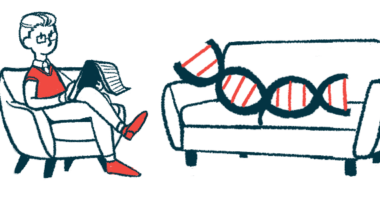Understanding epilepsy as the invisible aftermath of a brain bleed
The impact of a bleed in the brain can linger in the form of other conditions

My husband, Jared, was 11 when hemophilia changed the course of his life.
He wasn’t doing anything reckless — just being a boy, jumping around on his bed. Then came the misstep, the fall, the blow to his head. He brushed it off, not realizing that a slow, dangerous bleed was building inside his skull.
A couple of days later, he began to feel nauseous. His head hurt in a way he couldn’t describe; it was unlike any headache he’d had before. Then came the big seizure. He says he remembers everything, down to the terror of being fully conscious, yet unable to move or speak.
That head bleed marked the start of a long, painful chapter. Jared spent a month in the hospital, recovering from the intracranial hemorrhage while doctors tried to stabilize his new seizures with IV medication. Eventually, the bleeding stopped, but the seizures didn’t. They just evolved.
When bleeding leads to something more
According to a recent article in The Cureus Journal of Medical Science, epilepsy can develop as a rare complication of hemophilia, especially after brain bleeds. When blood seeps into brain tissue, it can leave behind scarring — areas where electrical signals misfire, creating a kind of “seizure generator.”
That’s exactly what happened to Jared. Imaging showed sclerosis in his right temporal lobe, the part of his brain that now sends out those rogue signals. Doctors diagnosed him with a focal impaired awareness seizure (previously called complex partial seizure), a type that starts on one side of the brain and affects awareness.
In everyday life, it looks nothing like what people picture when they hear epilepsy. There’s no dramatic convulsing. Instead, Jared might suddenly pause mid-sentence and start smacking his lips or appear to faint, then seem a little disoriented while he recovers. It lasts only a short while, but for him, it’s a reminder that his brain still carries traces of that childhood bleed. When you live with a bleeding disorder, you learn that recovery isn’t always linear. A bleed can heal, but sometimes, it leaves behind echoes.
Seeing through a child’s eyes
Our daughter has grown up with epilepsy as part of her reality. She has seen her dad have seizures since she was a toddler. At first, she accepted it as something that simply happens. She learned early on not to panic, that Daddy always comes back once the seizure subsides.
Now that she’s almost 7, her awareness has deepened. She’s asking new kinds of questions — not just what happens, but why. Why does Daddy sometimes not recognize her right away after a seizure? Why does he say or do odd things when he’s coming out of one? Why can’t he always answer her when she talks to him?
It’s both tender and complicated to explain that the same part of his brain that helps him recognize faces, names, and speech sometimes gets scrambled for a few moments. I tell her that it’s like his brain temporarily goes offline and needs to reboot. (Except it’s an old-fashioned computer that takes a few minutes to start up.)
Admittedly, I sometimes worry that these moments might scare or traumatize her. However, I’d rather see it as an opportunity to develop empathy — a quiet understanding that people can experience the world differently and still be whole.
Redefining recovery
In the hemophilia community, we often focus on preventing bleeds, and rightly so. But stories like Jared’s remind me that even when we win that battle, another can quietly begin. Brain bleeds don’t always end when the blood reabsorbs. Sometimes, their impact lingers in the form of conditions like epilepsy, depression, or cognitive changes.
For me, National Epilepsy Awareness Month is a reminder that every person with hemophilia carries invisible stories like Jared’s. Some of those stories begin with a bleed. Others begin with what happens after. Because healing isn’t just about clotting — it’s also about understanding what remains.
Note: Hemophilia News Today is strictly a news and information website about the disease. It does not provide medical advice, diagnosis, or treatment. This content is not intended to be a substitute for professional medical advice, diagnosis, or treatment. Always seek the advice of your physician or another qualified health provider with any questions you may have regarding a medical condition. Never disregard professional medical advice or delay in seeking it because of something you have read on this website. The opinions expressed in this column are not those of Hemophilia News Today or its parent company, Bionews, and are intended to spark discussion about issues pertaining to hemophilia.








Leave a comment
Fill in the required fields to post. Your email address will not be published.